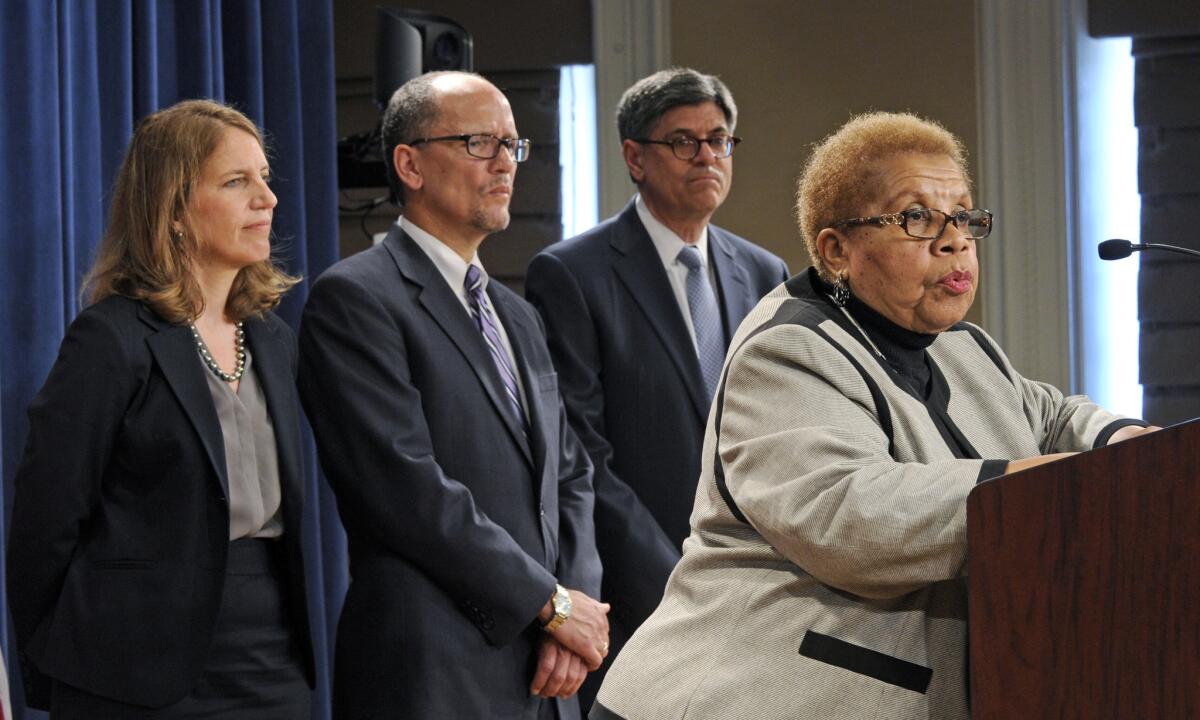Good news and warnings in the Social Security and Medicare reports

- Share via
The release of the annual trustees reports for Social Security and Medicare customarily give rise to an outburst of disinformation from the enemies of these social insurance programs -- that comes with the territory when you’re putting out documents of hundreds of pages densely packed with graphs, charts and statistics.
There may be less of that with the release of both reports Monday (months after the statutory deadline). That’s because “the news is essentially that there is no news” in the reports, as Kathy Ruffing of the Center on Budget and Policy Priorities, a leading expert on Social Security, said during a conference call Monday on the Social Security report.
The trustees still estimate that the Social Security trust fund will be exhausted in 2033 -- same as its estimate last year. The range of estimates -- for these things can never be exact -- places the date at some time between 2029 and 2041. Even then, the trustees say, there will still be enough money coming in to the program each year to pay 77% of currently scheduled benefits. And the trustees do, however, suggest that their best-case scenario for economic growth and other demographic and economic factors is brighter this year than it looked in 2013.
As of now, Social Security is in surplus (by $32 billion last year), and is expected to remain so on an annual basis at least through 2019.
Any way you look at it, this program is not bankrupt, and not going bankrupt. Anyone who claims it is has, by definition, given up his or her right to be taken seriously as a policy expert.
As for Medicare, there’s distinctly good news. The continuing drop in healthcare expenses has made Medicare healthier -- the estimated date of its trust fund’s depletion has been moved out by four years, to 2030. If you’re keeping track, that date has been moved off by a total of 13 years since enactment of the Affordable Care Act.
In the words of CBPP’s Paul van de Water, a former official of the Social Security Administration and the Congressional Budget Office, “Medicare spending per beneficiary in recent years has grown at historically low rates — 0.3 percent in 2012 and zero in 2013.”
The Medicare trustees specifically, though carefully, ascribe a large portion of this reduction to Obamacare -- to “substantial, but very uncertain, cost savings deriving from provisions of the Affordable Care Act.” These include reductions in the growth rate of reimbursements to doctors and hospitals.
Interestingly, the trustees suggest that the revised payment schedule will change patterns of healthcare delivery, as they should. Or else -- if physician and hospital methods of delivering care to patients don’ t change, the trustees say, then the changes in reimbursement probably won’t be “viable indefinitely.”
The most important cautions in the reports concern Social Security disability, which is very much in trouble and crying out for urgent action by Congress. The disability trust fund, which is separate from the old-age program’s trust fund, looks poised to run out in 2016. At that point the program will be able to pay out only 81% of disability benefits. That might reduce the average monthly disability benefit of $1,146 today to about $928.
The trustees suggest that Congress do the same thing to shore up disability that it did at the time of the last such crisis, in 1995: simply allocate more of the Social Security payroll tax from the old-age program to disability.
The payroll tax is currently 12.4% of wages (up to a maximum annual wage this year of $117,000. If the disability allocation rose from 0.9 of a percentage point to 1.4 points over the next couple of years and then drifted back down, the disability fund would remain solvent through 2033; the old age fund’s exhaustion date would shift only slightly, from 2034 to 2033. That would give Congress the better part of a couple of decades to work out a longer term fix.
But that requires Congress to get off its duff and treat the matter seriously. Are the lawmakers up to the challenge? Congressional conservatives, and a few lazy news organizations (I’m talking about you, “60 Minutes”) have spent the last few months demonizing the typical disability recipient as a layabout and malingerer, which is exactly contrary to the truth.
What’s scary is that their goal might be to rationalize cutting benefits in this all-important program, which represents a commitment made by the country to its most unfortunate workers. Social Security’s actuaries long ago established the disability case load is rising largely because of the aging of America, changes in the demographics of its work force, and the deterioration of the economy.
Disability standards are stringent, the program is hard to get on, it’s not a ticket to wealth or a comfortable lifestyle, and it needs to be protected, not hollowed out. Monday’s trustee’s report underscores that reality, if Congress would only pay attention.
After it gets back from its five-week vacation, that is.
Keep up to date with The Economy Hub by following @hiltzikm.
More to Read
Inside the business of entertainment
The Wide Shot brings you news, analysis and insights on everything from streaming wars to production — and what it all means for the future.
You may occasionally receive promotional content from the Los Angeles Times.











